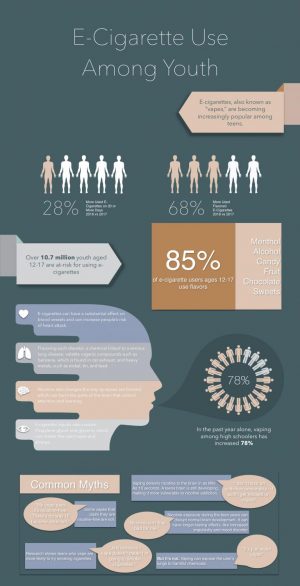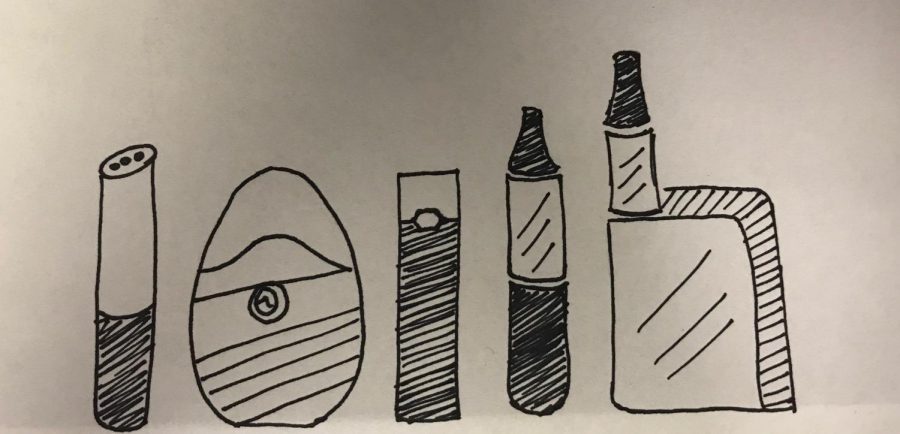Small device, huge problem
The use of e-cigarettes has become popular among teens, but the risks seem to be unknown.
This is a depiction of the various e-cigarettes or vapes that exist. These devices have increasingly become popular among teens even though dangers are still present.
February 12, 2019
Vape. A small device that has become an epidemic.
Invented in 1963 by Herbert A. Gilbert, vapes became popular in China by 2003. With 1.5 million more teens using e-cigarettes in 2018 compared to 2017 according to Center for Tobacco Products, vapes are now the most popular tobacco product among teens.

Data collected from the Center for Tobacco Products.
Since the increased popularity of e-cigarettes is relatively new in the United States, the dangers associated with them are not yet well-known, but researchers do know that there is a correlation between e-cigarettes and traditional cigarettes.
According to the National Institute on Drug Abuse, 30.7 percent of e-cigarette users start smoking within six months.
“A lot of people think that vaping is not smoking, but it is also the same chemicals,” School Resource Officer Robert Presswood said.
Benzene, which is also found in the exhaust from a car, is just one chemical that is often present in vapes. When students choose to vape in school, they are bringing this chemical into the school environment, which could be hazardous to those around them.
Not to mention, vaping in school is actually illegal.
“It [e-cigarettes] is still classified as a tobacco product, so you will probably get a citation [ticket] for minor in possession of tobacco,” Presswood said. “But there is also a law that states you can’t have that on school property, so you can get disciplined with a citation but also with the school too.”
These devices are not easy to spot as they are small. The JUUL, for example, is a brand of an e-cigarette that looks like a USB flash drive. It can even be charged by being plugged into a computer.
Students who are at school taking a “hit” or a quick smoke, usually do it in the bathroom or in an area where teachers are not present, but this small, often secretive act, is actually putting other students in danger because the oils that are in these vapes can be toxic.
Blowing the smoke that results from vaping has the potential to harm the people around the person who is vaping– just like second-hand smoke from a traditional cigarette.
According to the Center for Tobacco Control Research and Education, exposure to fine and ultrafine particles [in vapes] may exacerbate respiratory ailments like asthma, and constrict arteries which could trigger a heart attack.
“I do find it to be a problem because vape pens are battery operated devices that can look like a real cigarette or pen,” sophomore Rebecca Ekema said. “The problem is that they have containers filled with liquid that’s usually made of nicotine, flavorings, and other chemicals. Vaping can harm the developing brains of kids and could affect memory and attention.”
And industries designing and producing these e-cigarette devices are not making it easy on law enforcement who is trying to prevent students from using them.
“I think it makes it easier for people to use nicotine,” Elkhart Central’s School Resource Officer (SRO) Cody Skipper said. “The smoke does not stink like smoke coming from a cigarette, your clothes and house probably don’t smell like cigarettes if you are using e-cigarettes. So I think that is more attractive to young people especially. But the dangers of addiction are still there.”
But vaping is not just a problem at our high school, it is a problem across town at Elkhart Central, and is a problem world wide. The correlation between vaping and smoking tobacco is major, they are both a form of drug usage that is once again, illegal for anyone under the age of 18 and also illegal on school property.
At Elkhart Central, SRO Skipper follows protocol as is, an e-cigarette equals discipline.
Recognizing that vaping is the gateway to smoking cigarettes, which then may be the gateway to cancer is a major issue. An issue that needs to be brought to light for all teens because the consequences of vaping are not “cool” in the end.
“A way to prevent students from this habit is to go around to the elementary schools and middle schools, and maybe even high schools and talk to the students,” Ekema said. “Not saying scare them, but really show them the consequences of vaping.”








